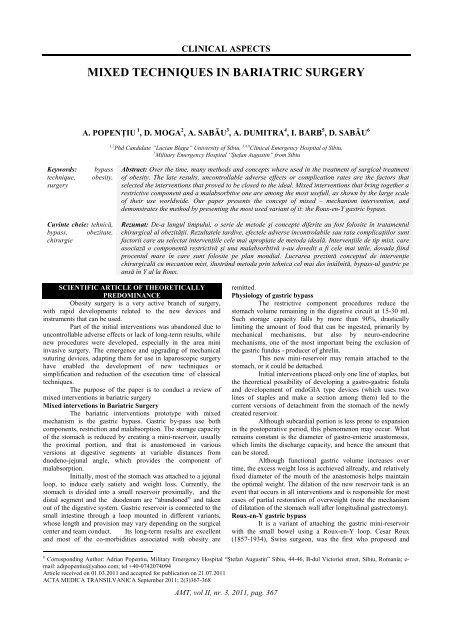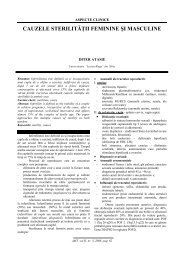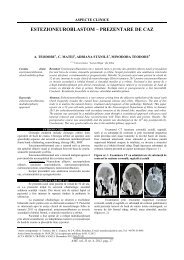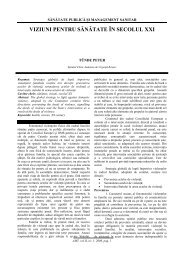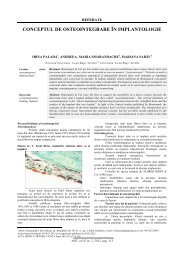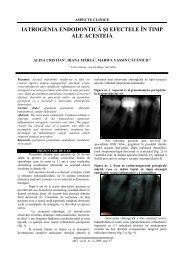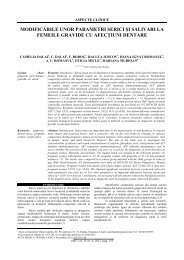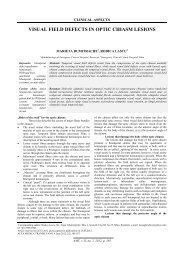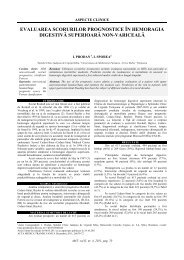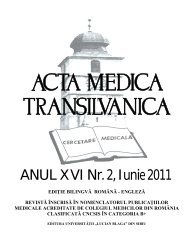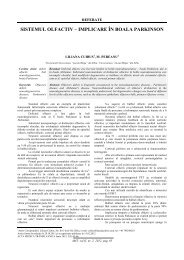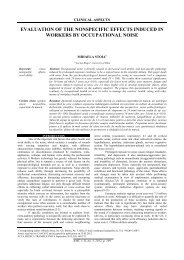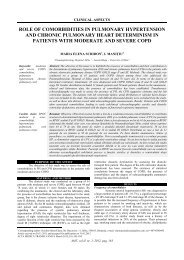Engleza nr 3-2011 - Acta Medica Transilvanica
Engleza nr 3-2011 - Acta Medica Transilvanica
Engleza nr 3-2011 - Acta Medica Transilvanica
Create successful ePaper yourself
Turn your PDF publications into a flip-book with our unique Google optimized e-Paper software.
CLINICAL ASPECTS<br />
MIXED TECHNIQUES IN BARIATRIC SURGERY<br />
A. POPENŢIU 1 , D. MOGA 2 , A. SABĂU 3 , A. DUMITRA 4 , I. BARB 5 , D. SABĂU 6<br />
1,2 Phd Candidate “Lucian Blaga” University of Sibiu, 3,4,6 Clinical Emergency Hospital of Sibiu,<br />
5 Military Emergency Hospital “Ştefan Augustin” from Sibiu<br />
Keywords:<br />
technique,<br />
surgery<br />
bypass<br />
obesity,<br />
Abstract: Over the time, many methods and concepts where used in the treatment of surgical treatment<br />
of obesity. The late results, uncontrollable adverse effects or complication rates are the factors that<br />
selected the interventions that proved to be closed to the ideal. Mixed interventions that bring together a<br />
restrictive component and a malabsorbtive one are among the most usefull, as shown by the large scale<br />
of their use worldwide. Our paper presents the concept of mixed – mechanism intervention, and<br />
demonstrates the method by presenting the most used variant of it: the Roux-en-Y gastric bypass.<br />
Cuvinte cheie: tehnică,<br />
bypass, obezitate,<br />
chirurgie<br />
Rezumat: De-a lungul timpului, o serie de metode şi concepte diferite au fost folosite în tratamentul<br />
chirurgical al obezităţii. Rezultatele tardive, efectele adverse incontrolabile sau rata complicaţiilor sunt<br />
factorii care au selectat intervenţiile cele mai apropiate de metoda ideală. Intervenţiile de tip mixt, care<br />
asociază o componentă restrictivă şi una malabsorbtivă s-au dovedit a fi cele mai utile, dovada fiind<br />
procentul mare în care sunt folosite pe plan mondial. Lucrarea prezintă conceptul de intervenţie<br />
chirurgicală cu mecanism mixt, ilustrând metoda prin tehnica cel mai des întâlnită, bypass-ul gastric pe<br />
ansă în Y al la Roux.<br />
SCIENTIFIC ARTICLE OF THEORETICALLY<br />
PREDOMINANCE<br />
Obesity surgery is a very active branch of surgery,<br />
with rapid developments related to the new devices and<br />
instruments that can be used.<br />
Part of the initial interventions was abandoned due to<br />
uncontrollable adverse effects or lack of long-term results, while<br />
new procedures were developed, especially in the area mini<br />
invasive surgery. The emergence and upgrading of mechanical<br />
suturing devices, adapting them for use in laparoscopic surgery<br />
have enabled the development of new techniques or<br />
simplification and reduction of the execution time of classical<br />
techniques.<br />
The purpose of the paper is to conduct a review of<br />
mixed interventions in bariatric surgery<br />
Mixed intervetions in Bariatric Surgery<br />
The bariatric interventions prototype with mixed<br />
mechanism is the gastric bypass. Gastric by-pass use both<br />
components, restriction and malabsorption. The storage capacity<br />
of the stomach is reduced by creating a mini-reservoir, usually<br />
the proximal portion, and that is anastomosed in various<br />
versions at digestive segments at variable distances from<br />
duodeno-jejunal angle, which provides the component of<br />
malabsorption.<br />
Initially, most of the stomach was attached to a jejunal<br />
loop, to induce early satiety and weight loss. Currently, the<br />
stomach is divided into a small reservoir proximally, and the<br />
distal segment and the duodenum are “abandoned” and taken<br />
out of the digestive system. Gastric reservoir is connected to the<br />
small intestine through a loop mounted in different variants,<br />
whose length and provision may vary depending on the surgical<br />
center and team conduct. Its long-term results are excellent<br />
and most of the co-morbidities associated with obesity are<br />
remitted.<br />
Physiology of gastric bypass<br />
The restrictive component procedures reduce the<br />
stomach volume remaining in the digestive circuit at 15-30 ml.<br />
Such storage capacity falls by more than 90%, drastically<br />
limiting the amount of food that can be ingested, primarily by<br />
mechanical mechanisms, but also by neuro-endocrine<br />
mechanisms, one of the most important being the exclusion of<br />
the gastric fundus - producer of ghrelin.<br />
This new mini-reservoir may remain attached to the<br />
stomach, or it could be dettached.<br />
Initial interventions placed only one line of staples, but<br />
the theoretical possibility of developing a gastro-gastric fistula<br />
and developement of endoGIA type devices (which uses two<br />
lines of staples and make a section among them) led to the<br />
current versions of detachment from the stomach of the newly<br />
created reservoir.<br />
Although subcardial portion is less prone to expansion<br />
in the postoperative period, this phenomenon may occur. What<br />
remains constant is the diameter of gastro-enteric anastomosis,<br />
which limits the discharge capacity, and hence the amount that<br />
can be stored.<br />
Although functional gastric volume increases over<br />
time, the excess weight loss is acchieved allready, and relatively<br />
fixed diameter of the mouth of the anastomosis helps maintain<br />
the optimal weight. The dilation of the new reservoir tank is an<br />
event that occurs in all interventions and is responsible for most<br />
cases of partial restoration of overweight (note the mechanism<br />
of dilatation of the stomach wall after longitudinal gastrectomy).<br />
Roux-en-Y gastric bypass<br />
It is a variant of attaching the gastric mini-reservoir<br />
with the small bowel using a Roux-en-Y loop. Cesar Roux<br />
(1857-1934), Swiss surgeon, was the first who proposed and<br />
1 Corresponding Author: Adrian Popentiu, Military Emergency Hospital “Ştefan Augustin” Sibiu, 44-46, B-dul Victoriei street, Sibiu, Romania; e-<br />
mail: adipopentiu@yahoo.com; tel +40-0742074094<br />
Article received on 01.03.<strong>2011</strong> and accepted for publication on 21.07.<strong>2011</strong><br />
ACTA MEDICA TRANSILVANICA September <strong>2011</strong>; 2(3)367-368<br />
AMT, vol II, <strong>nr</strong>. 3, <strong>2011</strong>, pag. 367
CLINICAL ASPECTS<br />
popularized this variation of the anastomosis, in order to shortcircuit<br />
the digestive segment, the first cases involving injuries or<br />
doudenal or gastric ulcer (1). The name comes from the<br />
similarity to a capital Y on schematic representation (Figure 1).<br />
The use in of bariatric surgery has been adopted in<br />
order to avoid adverse effects of a gastric reservoir anastomosis<br />
with the omega-type loop by Griffen (2). Positive results leaded<br />
to the wide addoption, especially in the U.S., where it is the<br />
intervention of bariatric surgery most often used today.<br />
Figure no. 1. Structure from gastric bypass (graphics by<br />
A. Popenţiu)<br />
patients;<br />
• Articular disease (lumbar diseases, artrodinies) improves<br />
spectacularly;<br />
• Circulatory phenomena of venous insufficiency (edema) -<br />
partially remitted.<br />
Improving co-morbidities (diabetes, dyslipidemia,<br />
hypertension, etc.) finally results in increased life expectancy,<br />
increased quality of life and a decrease in expenses related to<br />
health and social care. A study in Sweden on a group of obese<br />
diabetic patients showed a 80% reduction of annual mortality in<br />
patients who underwent bariatric surgery interventions,<br />
compared to a control group (6). Obese patients with diabetes in<br />
the group treated with surgery had a mortality of 9% at 9 years,<br />
compared with the control group, where mortality was 28%,<br />
with most deaths related to cardiovascular disease.<br />
MacDonald et al presented a study that patients with<br />
diabetes treated with oral hypoglycemic agents has a mortality<br />
rate of 4.5% for a period of 9 years of follow up, compared with<br />
only 1% for diabetic patients who underwent gastric bypass<br />
intervention (7).<br />
This intervention can be done entirely by laparoscopy<br />
and it was made for the first time in 1993 and Clark Wittgrove.<br />
Adapting mini invasive techniques has increased the popularity<br />
of the method, which is currently bariatric surgery most<br />
commonly used worldwide (3).<br />
Before the deveplopement of minimally invasive<br />
techniques, the Roux-en-Y gastric bypass was performed in<br />
many centers by classical approach, with good results on weight<br />
loss and acceptable peri-and postoperative complication rates.<br />
Results related to anastomotic dehiscence rate and<br />
other intra-abdominal complications are relatively comparable<br />
with data from the groups where the intervention was performed<br />
by laparoscopy, but reduced parietal complications and length of<br />
stay - shorter recovery, and reduced pulmonary complications<br />
percentage is favoring the laparoscopy.<br />
At present, issues related to costs involved are well studied, but<br />
although on short-term the laparoscopic interventions<br />
themselves are significantly more expensive, the benefits related<br />
to shortened hospital stay and faster socio-professional<br />
reintegration compensate for this relative disadvantage.<br />
Communicated results in literature<br />
In a retrospective study on a sample of 10,000 patients who<br />
underwent a gastric bypass, Griffen et al (4) obtained the<br />
following results: over 85% have lost at least 50% of excess<br />
body weight, and from 5000 patients followed by a period of 10<br />
years, 80% maintained this results.<br />
Another study followed 608 patients who were<br />
monitored for up to 14 years (5), and had a mean weight loss of<br />
75% at one year, but decreased to 50% by the eighth year.<br />
Positive metabolic effects are most representative<br />
image of improvement in comorbidities in patients from the<br />
studied groups:<br />
• Dyslipidemia is improved by over 70% of patients;<br />
• Essential hypertension is resolved over 70% of patients and<br />
for the rest the ammount of needed drugs to control it is<br />
much lower;<br />
• Type 2 diabetes is cured in up to 90% of patients, blood<br />
sugar values returned to normal very quickly,<br />
• Obstructive sleep apnea may disappear completely or be<br />
improved;<br />
• Gastro-esophageal reflux disease may disappear in most<br />
AMT, vol II, <strong>nr</strong>. 3, <strong>2011</strong>, pag. 368<br />
CONCLUSIONS<br />
Obesity currently reaches a global pandemic size,<br />
which raises serious medical, social and financial issues,<br />
including our country. Obesity and overweight induce an<br />
increased risk of developing chronic diseases such as type 2<br />
diabetes, cardiovascular disease, hypertension, cardiovascular<br />
disease and some cancers. Mixed surgical methods with<br />
restrictive and malabsorbtive components, are most commonly<br />
used with good results in terms of weight loss and low rate of<br />
complications<br />
BIBLIOGRAPHY<br />
1. C.Roux: De la gastroenterostomie. Revue de chirurgie,<br />
1893, 13: 402-403;<br />
2. Griffen W O, Bivins BA, Bell R M et all, Gastric bypass<br />
for morbid obesity, World J Surg, 1981; 5:817-22;<br />
3. Torres JC, Oca CF, Garrison RN. Gastric bypass: Rouxen-<br />
Y gastrojejunostomy from the lesser curvature. South Med<br />
J ;76:1217–21,1983;<br />
4. Griffen WO. Gastric bypass. In: Griffen WO, Printen KJ<br />
eds. Surgical management of morbid obesity. New York,<br />
NY. Marcel Dekker, Inc, 1987:27-45;<br />
5. Pories WJ, Swanson MS, MacDonald Kg et al. Who would<br />
have thought it? An operation proves to be the most<br />
effective therapy for adult onset diabetes mellitus. Ann<br />
Surg 1995; 222:339-52;<br />
6. Sjostrom C D, Lisnsner L, Wedel L H, Sjostrom L,<br />
Reduction in incidence of diabetes, hzpertension and lipid<br />
disturbances after intentional weight loss induced bz<br />
bariatric surgery. SOS Intervention Study, Obes Res<br />
1999,7, 477-484;<br />
7. MacDonald K G, Long S D, Swanson M S et al; The<br />
gastric bypass operation reduces the progression and<br />
mortality on non-insulin-dependent diabetes mellitus; J<br />
Gastrointest Surg ,1997;1;213-220.


